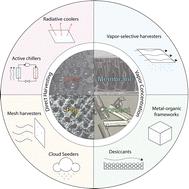当前位置:
X-MOL 学术
›
Energy Environ. Sci.
›
论文详情
Our official English website, www.x-mol.net, welcomes your
feedback! (Note: you will need to create a separate account there.)
Thermodynamic limits of atmospheric water harvesting
Energy & Environmental Science ( IF 32.4 ) Pub Date : 2022-09-13 , DOI: 10.1039/d2ee01071b Akshay K. Rao 1 , Andrew J. Fix 1 , Yun Chi Yang 1 , David M. Warsinger 1
Energy & Environmental Science ( IF 32.4 ) Pub Date : 2022-09-13 , DOI: 10.1039/d2ee01071b Akshay K. Rao 1 , Andrew J. Fix 1 , Yun Chi Yang 1 , David M. Warsinger 1
Affiliation

|
Atmospheric water harvesting (AWH) is a rapidly emerging approach for decentralized water production, but current technology is limited by trade-offs between energy consumption and yield. The field lacks a common basis to compare different AWH technologies and a robust understanding of the performance impacts of water recovery, desorption humidity (for sorbent systems), and realistic component-level efficiencies. By devising a set of unifying assumptions and consistent parameters across technologies, we provide the first fair thermodynamic comparison over a broad range of environmental conditions. Using 2nd law analysis, or least work, we study the maximum efficiency for common open system AWH methods – fog nets, dew plates, membrane-systems, and sorption processes – to identify the process performance limits. We find that the thermodynamic minimum for any AWH process is anywhere from 0× (relative humidity (RH) ≥ 100%) to upwards of 250× (RH < 10%) the minimum energy requirement of seawater desalination. Sorbents have a particular niche in colder (T < 310 K), arid regions (<6 g kg−1). Membrane-systems are best at low relative humidity and the region of applicability is strongly affected by vacuum pumping efficiency. Dew harvesting is best at higher humidity (RH > 40%) and fog harvesting is optimal when super-saturated conditions exist. Increasing efficiency at the component-level, particularly for vacuum pumps and condensers, may be the most promising avenue for improvement. Enabled by peta-scale computing, our findings use geographical and parametric mapping to provide a framework for technology deployment and energy-optimization.
中文翻译:

大气集水的热力学极限
大气集水 (AWH) 是一种迅速兴起的分散式水生产方法,但目前的技术受限于能源消耗和产量之间的权衡。该领域缺乏比较不同 AWH 技术的共同基础,也缺乏对水回收、解吸湿度(用于吸附剂系统)和实际组件级效率的性能影响的深入了解。通过设计一套跨技术的统一假设和一致参数,我们在广泛的环境条件下提供了第一个公平的热力学比较。使用第二定律分析或最少工作,我们研究了常见开放系统 AWH 方法(雾网、露水板、膜系统和吸附过程)的最大效率,以确定过程性能限制。我们发现,任何 AWH 过程的热力学最小值是从 0 倍(相对湿度 (RH) ≥ 100%)到 250 倍(RH < 10%)海水淡化的最低能量需求。吸附剂在较冷(T < 310 K),干旱地区 (<6 g kg -1 )。膜系统最适合低相对湿度,适用范围受真空泵效率的强烈影响。露水收集最好在较高湿度(RH > 40%)时收集,而当存在过饱和条件时,雾收集最好。提高组件级别的效率,尤其是真空泵和冷凝器的效率,可能是最有希望的改进途径。在 PB 级计算的支持下,我们的研究结果使用地理和参数映射来为技术部署和能源优化提供框架。
更新日期:2022-09-13
中文翻译:

大气集水的热力学极限
大气集水 (AWH) 是一种迅速兴起的分散式水生产方法,但目前的技术受限于能源消耗和产量之间的权衡。该领域缺乏比较不同 AWH 技术的共同基础,也缺乏对水回收、解吸湿度(用于吸附剂系统)和实际组件级效率的性能影响的深入了解。通过设计一套跨技术的统一假设和一致参数,我们在广泛的环境条件下提供了第一个公平的热力学比较。使用第二定律分析或最少工作,我们研究了常见开放系统 AWH 方法(雾网、露水板、膜系统和吸附过程)的最大效率,以确定过程性能限制。我们发现,任何 AWH 过程的热力学最小值是从 0 倍(相对湿度 (RH) ≥ 100%)到 250 倍(RH < 10%)海水淡化的最低能量需求。吸附剂在较冷(T < 310 K),干旱地区 (<6 g kg -1 )。膜系统最适合低相对湿度,适用范围受真空泵效率的强烈影响。露水收集最好在较高湿度(RH > 40%)时收集,而当存在过饱和条件时,雾收集最好。提高组件级别的效率,尤其是真空泵和冷凝器的效率,可能是最有希望的改进途径。在 PB 级计算的支持下,我们的研究结果使用地理和参数映射来为技术部署和能源优化提供框架。











































 京公网安备 11010802027423号
京公网安备 11010802027423号